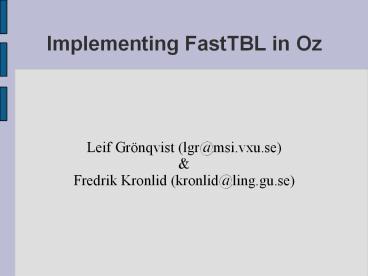Implementing FastTBL in Oz - PowerPoint PPT Presentation
1 / 18
Title:
Implementing FastTBL in Oz
Description:
... Data structures Programming paradigms Oz A multi-paradigm language Object-oriented Functional Concurrent Distributed Declarative Stateful .... Data & Paradigm We ... – PowerPoint PPT presentation
Number of Views:61
Avg rating:3.0/5.0
Title: Implementing FastTBL in Oz
1
Implementing FastTBL in Oz
- Leif Grönqvist (lgr_at_msi.vxu.se)
- Fredrik Kronlid (kronlid_at_ling.gu.se)
2
TBL
- The training phase
- Input
- Annotated corpus
- Rule templates
- Output
- Sequence of rules (best rule first)
- Annotation phase
- Input
- Sequence of rules
- Un-annotated corpus
- Lexicon for initial annotations
- Output
- Annotated corpus
3
Vanilla TBL (VTBL)
- Rules are selected greedy
- Corpus annotations updated after each rule
selected - Continue until enough rules or no errors left
- Number of possible rules in each iteration is
very high - Grows by tagset, number of templates, and number
of variables in templates - No results used from earlier iterations
4
TBL à la Ramshaw Marcus
- Only applicable rules, correcting at least one
sample is generated - The set of rules are saved between iterations
- For each rule there is
- a score
- a list of affected positions in the corpus
- For all samples there is a list of applicable
rules - Much faster than vanilla TBL
- Needs much more memory than VTBL
- The update of the needed structures takes a large
amount of the time used during training
5
FastTBL
- Ngai, G. Florian, R. (2001), Transformation-Base
d Learning in the Fast Lane, in Proceedings of
the 39th ACL Conference. - Similar to Ramshaw Marcus
- Only applicable rules, correcting at least one
sample is generated - The set of rules are saved between iterations
- For each rule there is
- a score consisting of the Good and Bad part
- For each selected rule, the scores for all rules
are updated - The vicinity of a sample tells the system which
samples the classification may depend on - Much faster than Ramshaw Marcus
- Needs much less memory than R M
6
The algorithm in a nutshell
7
Ngai Florians description
- Unclear what to store and how
- When should chosen rules be applied to the
corpus? - Notations like b(s) and p(b(s)) seem a bit sloppy
what do they mean? - b rule, p predicate, s sample
- How do we define vicinity?
- An algorithm description should describe the
algorithm
8
Implementation
- Oz
- Data structures
- Programming paradigms
9
Oz
- A multi-paradigm language
- Object-oriented
- Functional
- Concurrent
- Distributed
- Declarative
- Stateful
- ....
10
Data Paradigm
- We use functional programming, logic programming
and imperative programming techniques. - Functional programming some higher order
functions - Extensive use of tuples logic programming
- Corpus Array, Rule collection Dictionary
stateful structures, assignment works
11
Corpus representation
- Many ways to access data in Oz
- Data from µ-TBL (SUC)
- Solution
- (Script to transform SUC to µ-TBL format)
- Perl script for transforming SUC data into a
tuple in a functor (Oz module) - Tuple converted to Array for mutability
12
Template representation
- µ-TBL template representation allows
- Constraints on any feature
- Conjunction of constraints
- Disjunction of positions
- Target can change any feature
- tagAgtB lt- wdC_at_0 tagD_at_-1,-2
- Requires an elaborate template compiler
13
Templates contd
- FoztTBL templates allow
- Constraints on tags and words
- Conjunction of constraints
- The only target is change tag A into B
- Our template format also give the possibility to
generate rules on the form change any tag to B
14
Templates contd
- We use an extremely simple template formalism
- template(wd(0 0 c 0 0) tag(0 0 a d 0))
- tagAgtB lt- wdC_at_0 tagA_at_0 tagD_at_1
- A FoztTBL template is instantiated into a
Predicate by pattern matching
15
Representing the rules
- Rule predicate and target additional info
- Tuple of tuples
- rule(P T F UsedFlag)
- P predicate( wd(EMPTY EMPTY om EMPTY
EMPTY) tag(EMPTY EMPTY pp EMPTY EMPTY) ) - T target(sn)
- F f(Good, Bad)
- UsedFlag a flag to indicate whether the rule
has been applied or not - (tagppgtsn lt- wdom_at_0 tagpp_at_0)
16
Representing the rule collection
- FastTBL requirement instant (constant time)
access to all rules with a certain predicate - Oz Dictionaries hash tables with atoms as keys
- Solution
- Dictionary
- functions for rapid conversion predicate-atom
17
Conclusions
- FastTBL has
- Better time complexity than VTBL and RMTBL
- Uses less memory than VTBL
- Gives the same result
- The multiparadigmatic nature of Oz makes
programming easier - An algorithm appearing in a reviewed paper isn't
necessarily complete, comprehensible or easily
implementable.
18
Future Work
- Understand the algorithm in detail
- Read the C code
- Use the ideas in Ngai/Florian and reinvent it
- Implement and read Ngai/Florian iteratively using
a debugger - Finish off the implementation
- Improve on the clarity of the implementation and
the algorithm description - Make the template formalism more flexible,
keeping its simplicity































